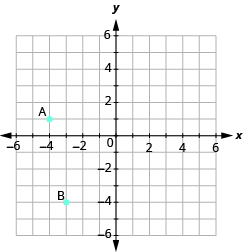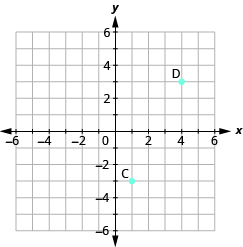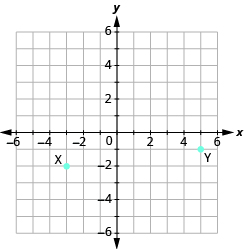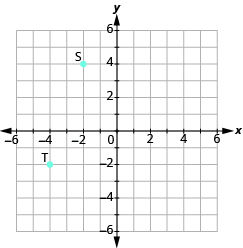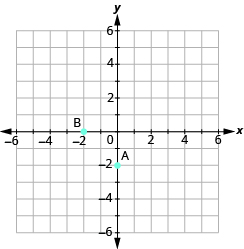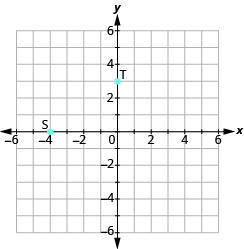11.2: Use the Rectangular Coordinate System (Part 2)
( \newcommand{\kernel}{\mathrm{null}\,}\)
Verify Solutions to an Equation in Two Variables
All the equations we solved so far have been equations with one variable. In almost every case, when we solved the equation we got exactly one solution. The process of solving an equation ended with a statement such as x = 4. Then we checked the solution by substituting back into the equation.
Here’s an example of a linear equation in one variable, and its one solution.
3x+5=173x=12x=4
But equations can have more than one variable. Equations with two variables can be written in the general form Ax + By = C. An equation of this form is called a linear equation in two variables.
An equation of the form Ax + By = C, where A and B are not both zero, is called a linear equation in two variables.
Notice that the word “line” is in linear.
Here is an example of a linear equation in two variables, x and y:
Ax+By=Cx+4y=8A=1,B=4,C=8
Is y = −5x + 1 a linear equation? It does not appear to be in the form Ax + By = C. But we could rewrite it in this form.
| y=−5x+1 | |
| Add 5x to both sides. | y+5x=−5x+1+5x |
| Simplify. | y+5x=1 |
| Use the Commutative Property to put it in Ax + By = C. | Ax+By=C5+y=1 |
By rewriting y = −5x + 1 as 5x + y = 1, we can see that it is a linear equation in two variables because it can be written in the form Ax + By = C.
Linear equations in two variables have infinitely many solutions. For every number that is substituted for x, there is a corresponding y value. This pair of values is a solution to the linear equation and is represented by the ordered pair (x, y). When we substitute these values of x and y into the equation, the result is a true statement because the value on the left side is equal to the value on the right side.
An ordered pair (x, y) is a solution to the linear equation Ax + By = C, if the equation is a true statement when the x- and y-values of the ordered pair are substituted into the equation.
Determine which ordered pairs are solutions of the equation x + 4y = 8: (a) (0, 2) (b) (2, −4) (c) (−4, 3)
Solution
Substitute the x- and y-values from each ordered pair into the equation and determine if the result is a true statement.
| (a) (0, 2) | (b) (2, −4) | (c) (−4, 3) |
| x=0,y=2x+4y=80+4⋅2?=80+8?=88=8✓ | x=2,y=−4x+4y=82+4(−4)?=82+(−16)?=8−14≠8 | x=−4,y=3x+4y=8−4+4⋅3?=8−4+12?=88=8✓ |
| (0, 2) is a solution. | (2, −4) is not a solution. | (−4, 3) is a solution. |
Determine which ordered pairs are solutions to the given equation: 2x + 3y = 6
(a) (3, 0) (b) (2, 0) (c) (6, −2)
- Answer
-
(a), (c)
Determine which ordered pairs are solutions to the given equation: 4x − y = 8
(a)(0, 8) (b) (2, 0) (c) (1, −4)
- Answer
-
(b), (c)
Determine which ordered pairs are solutions of the equation. y = 5x − 1: (a) (0, −1) (b) (1, 4) (c) (−2, −7)
Solution
Substitute the x- and y-values from each ordered pair into the equation and determine if it results in a true statement.
| (a) (0, -1) | (b) (1, 4) | (c) (−2, -7) |
| x=0,y=−1y=5x−1−1?=5(0)−1−1?=0−1−1=−1✓ | x=1,y=4y=5x−14?=5(1)−14?=5−14=4✓ | x=−2,y=−7y=5x−1−7?=5(−2)−1−7?=−10−1−7≠−11 |
| (0, -1) is a solution. | (1, 4) is a solution. | (−2, -7) is not a solution. |
Determine which ordered pairs are solutions of the given equation: y = 4x − 3
(a) (0, 3) (b) (1, 1) (c) (1, 1)
- Answer
-
(b)
Determine which ordered pairs are solutions of the given equation: y = −2x + 6
(a)(0, 6) (b) (1, 4) (c) (−2, −2)
- Answer
-
(a), (b)
Complete a Table of Solutions to a Linear Equation
In the previous examples, we substituted the x- and y-values of a given ordered pair to determine whether or not it was a solution to a linear equation. But how do we find the ordered pairs if they are not given? One way is to choose a value for x and then solve the equation for y. Or, choose a value for y and then solve for x.
We’ll start by looking at the solutions to the equation y = 5x − 1 we found in Example 11.2.1. We can summarize this information in a table of solutions.
| y = 5x − 1 | ||
|---|---|---|
| x | y | (x, y) |
| 0 | -1 | (0, -1) |
| 1 | 4 | (1, 4) |
To find a third solution, we’ll let x = 2 and solve for y.
| y=5x−1 | |
| Substitute x = 2. | y=5(2)−1 |
| Multiply. | y=10−1 |
| Simplify. | y=9 |
The ordered pair is a solution to y = 5x - 1. We will add it to the table.
| y = 5x − 1 | ||
|---|---|---|
| x | y | (x, y) |
| 0 | -1 | (0, -1) |
| 1 | 4 | (1, 4) |
| 2 | 9 | (2, 9) |
We can find more solutions to the equation by substituting any value of x or any value of y and solving the resulting equation to get another ordered pair that is a solution. There are an infinite number of solutions for this equation.
Complete the table to find three solutions to the equation y = 4x − 2:
| y = 4x - 2 | ||
|---|---|---|
| x | y | (x, y) |
| 0 | ||
| -1 | ||
| 2 | ||
Solution
Substitute x = 0, x = −1, and x = 2 into y = 4x − 2.
| x = 0 | x = −1 | x = 2 |
| y = 4x − 2 | y = 4x − 2 | y = 4x − 2 |
| y = 4 • 0 − 2 | y = 4(−1) − 2 | y = 4 • 2 − 2 |
| y = 0 − 2 | y = −4 − 2 | y = 8 − 2 |
| y = −2 | y = −6 | y = 6 |
| (0, −2) | (−1, −6) | (2, 6) |
The results are summarized in the table.
| y = 4x - 2 | ||
|---|---|---|
| x | y | (x, y) |
| 0 | -2 | (0, -2) |
| -1 | -6 | (-1, -6) |
| 2 | 6 | (2, 6) |
Complete the table to find three solutions to the equation: y = 3x − 1.
| y = 3x − 1 | ||
|---|---|---|
| x | y | (x, y) |
| 0 | ||
| -1 | ||
| 2 | ||
- Answer
-
y = 3x − 1 x y (x, y) 0 -1 (0, -1) -1 -4 (-1, -4) 2 5 (2, 5)
Complete the table to find three solutions to the equation: y = 6x + 1.
| y = 6x + 1 | ||
|---|---|---|
| x | y | (x, y) |
| 0 | ||
| 1 | ||
| -2 | ||
- Answer
-
y = 6x + 1 x y (x, y) 0 1 (0, 1) -1 7 (1, 7) 2 -11 (-2, -11)
Complete the table to find three solutions to the equation 5x − 4y = 20:
| 5x − 4y = 20 | ||
|---|---|---|
| x | y | (x, y) |
| 0 | ||
| 0 | ||
| 5 | ||
Solution
| x=05x−4y=205⋅0−4y=200−4y=20−4y=20y=−5(0,−5) | y=05x−4y=205x−4⋅0=205x−0=205x=20x=4(4,0) | y=55x−4y=205x−4⋅5=205x−20=205x=40x=8(8,5) |
The results are summarized in the table.
| 5x − 4y = 20 | ||
|---|---|---|
| x | y | (x, y) |
| 0 | -5 | (0, -5) |
| 4 | 0 | (-4, 0) |
| 8 | 5 | (8, 5) |
Complete the table to find three solutions to the equation: 2x − 5y = 20.
| 2x - 5y = 20 | ||
|---|---|---|
| x | y | (x, y) |
| 0 | ||
| 0 | ||
| -5 | ||
- Answer
-
2x - 5y = 20 x y (x, y) 0 -4 (0, -4) 10 0 (10, 0) -5 -6 (-5, -6)
Complete the table to find three solutions to the equation: 3x − 4y = 12.
| 3x - 4y = 12 | ||
| x | y | (x, y) |
| 0 | ||
| 0 | ||
| -4 | ||
- Answer
-
3x - 4y = 12 x y (x, y) 0 -3 (0, -3) 4 0 (4, 0) -4 -6 (-4, -6)
Find Solutions to Linear Equations in Two Variables
To find a solution to a linear equation, we can choose any number we want to substitute into the equation for either x or y. We could choose 1, 100, 1,000, or any other value we want. But it’s a good idea to choose a number that’s easy to work with. We’ll usually choose 0 as one of our values.
Find a solution to the equation 3x + 2y = 6.
Solution
| Step 1: Choose any value for one of the variables in the equation. |
We can substitute any value we want for x or any value for y. Let's pick x = 0. What is the value of y if x = 0? |
|
| Step 2: Substitute that value into the equation. Solve for the other variable. |
Substitute 0 for x. Simplify. Divide both sides by 2. |
3x+2y=63⋅0+2y=60+2y=62y=6y=3 |
| Step 3: Write the solution as an ordered pair. | So, when x = 0, y = 3. | This solution is represented by the ordered pair (0, 3). |
| Step 4: Check. |
Substitute x = 0, y = 3 into the equation 3x + 2y = 6. Is the result a true equation? Yes! |
3x+2y=63⋅0+2⋅3?=60+6?=66=6✓ |
Find a solution to the equation: 4x + 3y = 12.
- Answer
-
Answers will vary
Find a solution to the equation: 2x + 4y = 8.
- Answer
-
Answers will vary
We said that linear equations in two variables have infinitely many solutions, and we’ve just found one of them. Let’s find some other solutions to the equation 3x + 2y = 6.
Find three more solutions to the equation 3x + 2y = 6.
Solution
To find solutions to 3x + 2y = 6, choose a value for x or y. Remember, we can choose any value we want for x or y. Here we chose 1 for x, and 0 and −3 for y.
| Substitute it into the equation. | y=03x+2y=63x+2(0)=6 | x=13x+2y=63(1)+2y=6 | y=−33x+2y=63x+2(−3)=6 |
| Simplify. Solve. | 3x+0=63x=6 | 3+2y=62y=3 | 3x−6=63x=12 |
| x = 2 | y = 32 | x = 4 | |
| Write the ordered pair. | (2, 0) | (1, 32) | (4, −3) |
Check your answers.
| (2, 0) | (1, 32) | (4, −3) |
| 3x+2y=63⋅2+2⋅0?=66+0?=66=6✓ | 3x+2y=63⋅1+2⋅32?=63+3?=66=6✓ | 3x+2y=63⋅4+2⋅(−3)?=612+(−6)?=66=6✓ |
So (2, 0), (1, 32) and (4, −3) are all solutions to the equation 3x + 2y = 6. In the previous example, we found that (0, 3) is a solution, too. We can list these solutions in a table.
| 3x + 2y = 6 | ||
|---|---|---|
| x | y | (x, y) |
| 0 | 3 | (0, 3) |
| 2 | 0 | (2, 0) |
| 1 | 32 | (1, 32) |
| 4 | -3 | (4, -3) |
Find three solutions to the equation: 2x + 3y = 6.
- Answer
-
Answers will vary
Find three solutions to the equation: 4x + 2y = 8.
- Answer
-
Answers will vary
Let’s find some solutions to another equation now.
Find three solutions to the equation x − 4y = 8.
Solution
| Choose a value for x or y. | x = 0 | y = 0 | y = 3 |
| Substitute it into the equation. | 0−4y=8 | x−4⋅0=8 | x−4⋅3=8 |
| Solve. | −4y=8y=−2 | x−0=8x=8 | x−12=8x=20 |
| Write the ordered pair. | (0, −2) | (8, 0) | (20, 3) |
So (0, −2), (8, 0), and (20, 3) are three solutions to the equation x − 4y = 8.
| x − 4y = 8 | ||
|---|---|---|
| x | y | (x, y) |
| 0 | -2 | (0, -2) |
| 8 | 0 | (8, 0) |
| 20 | 3 | (20, 3) |
Remember, there are an infinite number of solutions to each linear equation. Any point you find is a solution if it makes the equation true.
Find three solutions to the equation: 4x + y = 8.
- Answer
-
Answers will vary
Find three solutions to the equation: x + 5y = 10.
- Answer
-
Answers will vary
Plotting Points
Identifying Quadrants
Verifying Solution to Linear Equation
Practice Makes Perfect
Plot Points on a Rectangular Coordinate System
In the following exercises, plot each point on a coordinate grid.
- (3, 2)
- (4, 1)
- (1, 5)
- (3, 4)
- (4, 1), (1, 4)
- (3, 2), (2, 3)
- (3, 4), (4, 3)
In the following exercises, plot each point on a coordinate grid and identify the quadrant in which the point is located.
- (a) (−4, 2) (b) (−1, −2) (c) (3, −5) (d) (2,52)
- (a) (−2, −3) (b) (3, −3) (c) (−4, 1) (d) (1,32)
- (a) (−1, 1) (b) (−2, −1) (c) (1, −4) (d) (3,72)
- (a) (3, -2) (b) (−3, 2) (c) (-3, −2) (d) (3, 2)
- (a) (4, -1) (b) (−4, 1) (c) (-4, -1) (d) (4, 1)
- (a) (−2, 0) (b) (−3, 0) (c) (0, 4) (d) (0, 2)
Identify Points on a Graph
In the following exercises, name the ordered pair of each point shown.
Verify Solutions to an Equation in Two Variables
In the following exercises, determine which ordered pairs are solutions to the given equation.
- 2x + y = 6
- (1, 4)
- (3, 0)
- (2, 3)
- x + 3y = 9
- (0, 3)
- (6, 1)
- (-3, -3)
- 4x − 2y = 8
- (3, 2)
- (1, 4)
- (0, -4)
- 3x − 2y = 12
- (4, 0)
- (2, -3)
- (1, 6)
- y = 4x + 3
- (4, 3)
- (-1, -1)
- (12, 5)
- y = 2x − 5
- (0, -5)
- (2, 1)
- (12, -4)
- y = 12x − 1
- (2, 0)
- (-6, -4)
- (-4, -1)
- y = 13 x + 1
- (-3, 0)
- (9, 4)
- (-6, -1)
Find Solutions to Linear Equations in Two Variables
In the following exercises, complete the table to find solutions to each linear equation.
y = 2x − 4
| x | y | (x, y) |
|---|---|---|
| -1 | ||
| 0 | ||
| 2 |
- y = 3x − 1
| x | y | (x, y) |
|---|---|---|
| -1 | ||
| 0 | ||
| 2 |
- y = − x + 5
| x | y | (x, y) |
|---|---|---|
| -2 | ||
| 0 | ||
| 3 |
- y = 13x + 1
| x | y | (x, y) |
|---|---|---|
| 0 | ||
| 3 | ||
| 6 |
- y = −32x − 2
| x | y | (x, y) |
|---|---|---|
| -2 | ||
| 0 | ||
| 2 |
- x + 2y = 8
| x | y | (x, y) |
|---|---|---|
| 0 | ||
| 4 | ||
| 0 |
Everyday Math
- Weight of a baby Mackenzie recorded her baby’s weight every two months. The baby’s age, in months, and weight, in pounds, are listed in the table, and shown as an ordered pair in the third column.
- Plot the points on a coordinate grid.
- Why is only Quadrant I needed?
| Age | Weight | (x, y) |
|---|---|---|
| 0 | 7 | (0, 7) |
| 2 | 11 | (2, 11) |
| 4 | 15 | (4, 15) |
| 6 | 16 | (6, 16) |
| 8 | 19 | (8, 19) |
| 10 | 20 | (10, 20) |
| 12 | 21 | (12, 21) |
- Weight of a child Latresha recorded her son’s height and weight every year. His height, in inches, and weight, in pounds, are listed in the table, and shown as an ordered pair in the third column.
- Plot the points on a coordinate grid.
- Why is only Quadrant I needed?
| Height | Weight | (x, y) |
| 28 | 22 | (28, 22) |
| 31 | 27 | (31, 27) |
| 33 | 33 | (33, 33) |
| 37 | 35 | (37, 35) |
| 40 | 41 | (40, 41) |
| 42 | 45 | (42, 45) |
Writing Exercises
- Have you ever used a map with a rectangular coordinate system? Describe the map and how you used it.
- How do you determine if an ordered pair is a solution to a given equation?
Self Check
(a) After completing the exercises, use this checklist to evaluate your mastery of the objectives of this section.
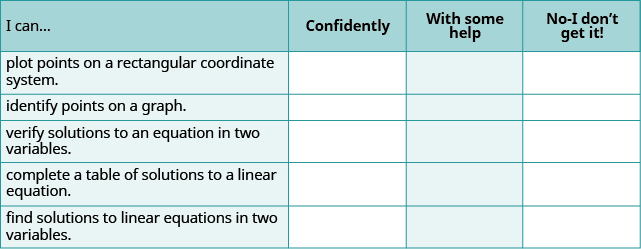
(b) If most of your checks were:
…confidently. Congratulations! You have achieved the objectives in this section. Reflect on the study skills you used so that you can continue to use them. What did you do to become confident of your ability to do these things? Be specific.
…with some help. This must be addressed quickly because topics you do not master become potholes in your road to success. In math, every topic builds upon previous work. It is important to make sure you have a strong foundation before you move on. Who can you ask for help? Your fellow classmates and instructor are good resources. Is there a place on campus where math tutors are available? Can your study skills be improved?
…no—I don’t get it! This is a warning sign and you must not ignore it. You should get help right away or you will quickly be overwhelmed. See your instructor as soon as you can to discuss your situation. Together you can come up with a plan to get you the help you need.
Contributors and Attributions
Lynn Marecek (Santa Ana College) and MaryAnne Anthony-Smith (Formerly of Santa Ana College). This content is licensed under Creative Commons Attribution License v4.0 "Download for free at http://cnx.org/contents/fd53eae1-fa2...49835c3c@5.191."



